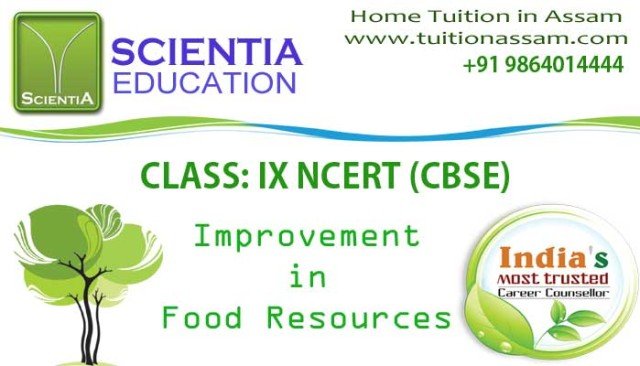
CLASS: IX NCERT (CBSE)
Improvement in Food Resources
SUMMARY
The green revolution contributed to increased food-grain production, and the white revolution contributed to increased availability of milk.
Sources of Nutrition include cereals, pulses, oil seeds, vegetables, spices and fruits.
Kharif crops are grown in the rainy season, which is from June to October.
Rabi crops are grown in the winter season from November to April. Desirable traits are incorporated into the plant by hybridisation.
Genetic modification in plants produced plants that are able to survive in a drought and water logged conditions.
Macronutrients includes nitrogen, phosphorous, potassium, calcium, magnesium, and sulphur. Micronutrients includes iron, manganese, boron, zinc, copper, molybdenum and chlorine.
Manure increases soil fertility. Types of manure includes compost, vermi-compost and green manure.
Fertilizers supply nitrogen, phosphorus and potassium to the plants.
Blue green algae are used as biofertilizers and neem leaves or turmeric are used as biopesticides.
Irrigation is the artificial supply of water to the soil by means such as wells, canals, rivers and tanks.
Types of wells include dug well and tube well. When canal flow is insufficient due to inadequate reservoir release, river lift systems are used.
Rainwater harvesting increases the ground water levels and reduce soil erosion.
Cropping patterns -Types: mixed cropping, inter cropping and crop rotation. Nurturing crop plants against the damages caused by weeds, pests and diseases is crop protection management.
Diseases in plants are caused by pests, bacteria, fungi and viruses and can be controlled by spraying pesticides, insecticides and fungicides. Exposure to chemical fumes kills pests, called fumigation.
Animal husbandry is the farming and management of animal livestock including cattle, goat, sheep, poultry, and fish.
The practice of rearing cattle is cattle farming. Milk-producing female animals are dairy animals.
Male cattle used for farm labour are draught animals.
Roughage feed contain high fibre content and concentrate feed contain low fibre and high protein content.
Diseases in cattle are caused by external parasites and internal parasites. The period following the birth of a calf is lactation period.
Cross breeding in cows lead to a new breed with a long lactation period as well as a strong resistance to diseases. Poultry farmingis the practice of raising poultry.
Cross-breeding in poultry lead to new varieties with desirable traits. Enclosures like tanks are used to produce fish for commercial purposes, called fish farming or aquaculture.
Capture fishing involves obtaining fish from natural resources and culture fishing involves culturing the fish in small enclosures. Fishing in saltwater regions is called Marine Fisheries.
Mariculture involves culturing of fish in marine water.
Inland fisheries comprise canals and reservoirs where fish are trapped or captured. Another rich source of fish are found in reservoirs where fresh water and sea water mix, these regions are called estuaries.
Composite Fish Farming is intensive fish farming of five or six fish species, with different food habits in a single fishpond. Practice of maintaining honey bee colonies in beehives is called bee-keeping or apiculture.
Beehives are enclosed structures in which honey bees live and raise their young. Varieties of honey-bees are Apis cerana indica, Apis dorsata and Apis florae.














